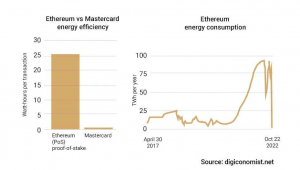Has the carbon issue been resolved by crypto?

Has crypto actually found a solution to the carbon issue, or is this just wishful thinking?
Cryptocurrencies have long been portrayed as the villains of fairytale climate stories who abuse ever-increasing power for what appears to be the benefit of a select few. The narrative has now changed direction. The second-largest cryptocurrency in the world, Ethereum, has disclosed changes to its multi-billion dollar operations that should lower its overall energy consumption by almost 99%. Could this indicate that cryptocurrency is beginning to evolve into the decentralized system that its proponents have long claimed it will be, revolutionizing banking, economics, and perhaps even environmental policy? Or will everything resume as usual when twelve o’clock rolls around?
Crypto Is Beginning to Get Green
1. Less emissions and fewer calculations
Traditional cryptocurrency may have been created by the fossil fuel industry; in order to create new currencies, users must solve ever-harder mathematical puzzles, necessitating larger and larger server farms. Ethereum slows down that oncoming train with some terrifyingly difficult calculations that require a lot less computing power. As a result, Ethereum should use less energy globally than a thousand normal US houses, as opposed to using as much as the entire Netherlands does each year.
2. An ecology that is more resilient?
Ethereum is a blockchain platform that supports digital artwork NFTs for hundreds of millions of dollars as well as prospective smart contracts that might provide security and transparency. It is not only a coin. Academics have long maintained that if energy use could be reduced, blockchain technologies could enable more affordable, intelligent emissions trading schemes, the monitoring of recycled goods, and green financing. The possibilities are well-discussed in this Financial Times podcast.
3. More coins, less carbon
There are various carbon-backed currencies that specifically aim to combat climate change, frequently by connecting new coins to the issuance of carbon credits, however they are currently just a minuscule fraction the size of Ethereum or Bitcoin. Each currency you purchase, for instance, is a representation of actual carbon assets, like trees. To investigate their potential advantages, the World Economic Forum recently established a Crypto Impact and Sustainability Accelerator.
Less Bad Isn’t Always Good, and vice versa
1. Still a power guzzler
According to Digiconomist, although Ethereum uses less energy than it once did, it still consumes approximately 20 times as much energy each transaction as a centralized system like Mastercard. There is an opportunity cost because this work is essentially extra and wasteful in comparison to functional alternatives, claims Maximilian Holland in CleanTechnica. This is the chance that was lost to employ this energy for household well-being and other essential economic functions.
2. The enormous elephant in the room – Bitcoin
Crypto mining is not about smart contracts; it’s about making rapid cash. According to the BBC, some Ethereum miners are already resuming their efforts to mine Bitcoin. The largest and most energy-intensive cryptocurrency, Bitcoin uses around 0.5 percent of the global electricity produced. This is explained in a recent research from the University of New Mexico published in Nature. According to research, the production of beef or the usage of fuel cause $0.35 in global climate damages for every $1 that is made in bitcoin.
3. A cacophony of con games
A scandal involving misplaced coins, hacked blockchains, or stolen cryptocurrency wallets almost always makes headlines. When technology and the social institutions that support it are truly impervious to harm, decentralization is fantastic. However, it is less desirable when your life savings—or carbon credits—are continuously at risk.
What to Pay Attention To
Will Bitcoin imitate Ethereum’s model?
Although it presently seems unlikely that Bitcoin would switch to more energy-efficient operations, a seamless Ethereum transition—along with this winter’s unusually high energy prices—could reignite discussions about Bitcoin’s excessive energy consumption.
Costs of computer chips
Since the beginning of the year, the average cost of the lightning-fast GPU processors used by cryptocurrency miners has decreased by half. Ethereum’s reforms are partly to blame for this decline, but regulators are also considering setting restrictions on mining cryptocurrencies that consume a lot of energy. The US government was tasked with monitoring and overseeing the carbon impact of cryptocurrencies in a study on the climate and energy implications of crypto assets that was published by the White House in August. In the end, coin miners might discover that their computer farms are stranded, similar to offshore oil reserves.
The bright side of the crypto meltdown.
Over the summer, a lot of cryptocurrencies had significant value losses. There is a chance for some of the more socially beneficial components of blockchain technology to take center stage as cryptocurrency loses its appeal as a speculative asset.
IMPT Token Presale
IMPT.io is a brand-new project focused on using blockchain technology for a greener world, aiming to transform the opaque carbon credit market by incentivizing individuals and companies to reduce CO2 emissions.
IMPT’s primary service is streamlining the process of obtaining and trading carbon credits, which play a fundamental role in the fight against climate change. These carbon credits are essentially contracts that allow the holder to emit a specific amount of CO2 into the atmosphere. Each carbon credit typically relates to one ton of carbon dioxide emissions.
Interestingly, these carbon credits can also be traded, with prices decided based on the laws of supply and demand.
As noted in IMPT’s whitepaper, the volume of carbon credits required globally is expected to increase at least 20-fold by 2035. This increase in demand necessitates a safe and transparent marketplace that allows individuals and companies to work together for the common good.
This is where IMPT comes in, as its blockchain-based platform helps eradicate the ‘double-selling’ within the carbon credit market. Moreover, IMPT makes it easy for individuals to help the environment by allowing them to acquire carbon credits through their everyday shopping activities.
IMPT raises $1,630,597.392 in the first 4 days of the presale
The presale for IMPT has commenced, and the project has already managed to raise over 1.6 million dollars. As the presale progresses, the price will steadily rise, meaning that the earliest buyers are the ones who will end with the best deal.
While there was a brief early adopter sale, right now, IMPT is in its first presale phase with IMPT tokens being sold for just $0.018. There are a total of 600,000,000 tokens (3 billion IMPT is the max supply) up for grabs during this round, with a further 660 million to be sold for $0.023 during round two, and another 540 million to be sold during the third and final presale phase for $0.0280.
Over 10,000 brands are ready to join IMPT.io
So far, according to the project’s website, over 10,000 brands have agreed to join IMPT.io and to work with them in the future as part of their mission to reduce emissions.
This means we could see some impressive growth for IMPT upon its release. With IMPT tokens expected to sell for $0.0280 during the phase three presale, we could estimate that IMPT will likely list for between $0.028 to $0.06. This would see early presale investors making a sizable profit immediately and with more growth expected soon after the project is released, we could see prices climb far higher soon after the token becomes available on exchanges around the world.
Cash back in IMPT on spending
One of the main incentives for people use IMPT is the fact that they are able to earn cashback on spending.
Every time someone makes a purchase through the platform, they can opt to become part of the solution for high carbon emissions, by earning IMPT tokens in return. Those who earn IMPT can then choose to use the tokens to acquire carbon credits as NFTs.
Related
- Crypto’s journey to going green; the IMPT project
- Ethereum Merge Completed. World’s Second Biggest Blockchain Enters Golden Age
- IMPT Token Raises $220,000 in first 24 hours of presale – Best Green Crypto for 2022?
Tamadoge – Play to Earn Meme Coin
- Earn TAMA in Battles With Doge Pets
- Maximum Supply of 2 Bn, Token Burn
- Now Listed on OKX, Bitmart, Uniswap
- Upcoming Listings on LBank, MEXC
Powered by WPeMatico







